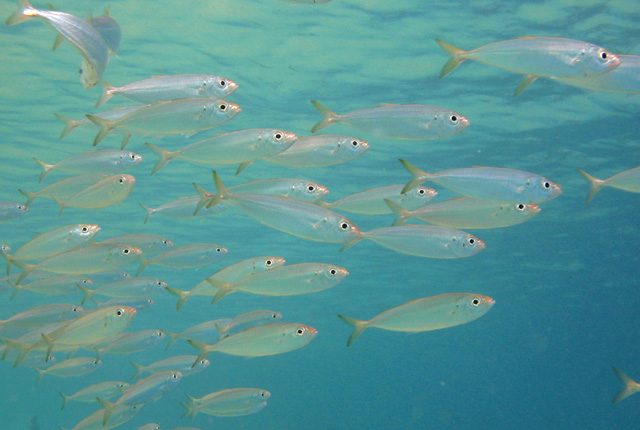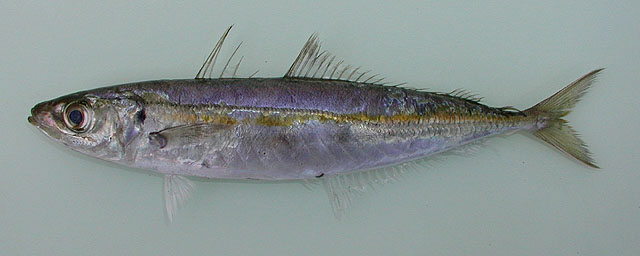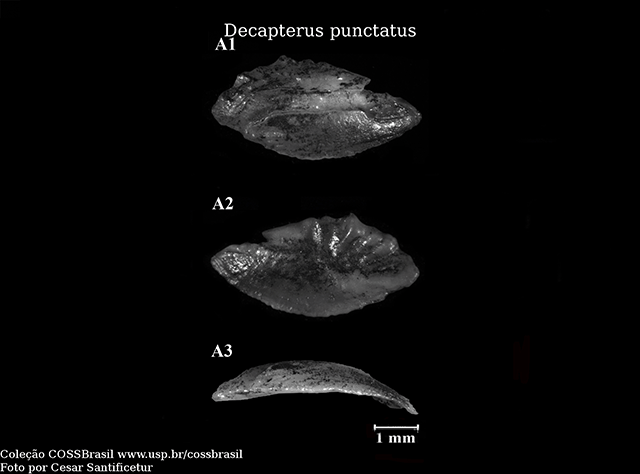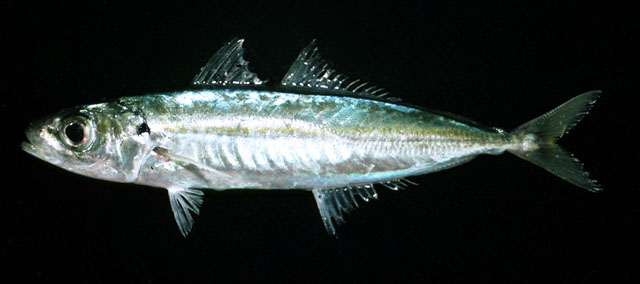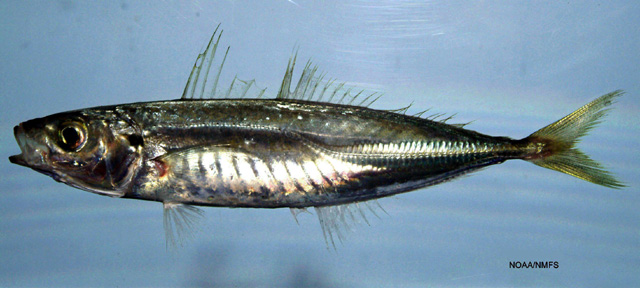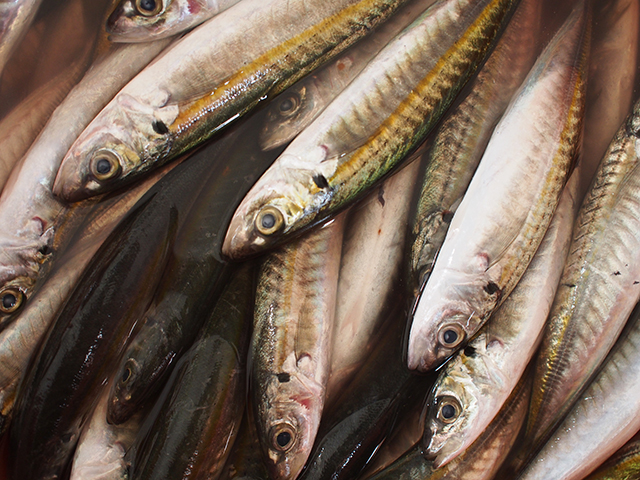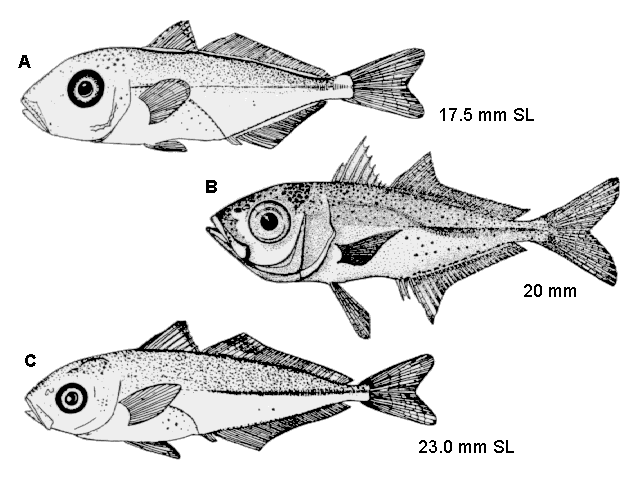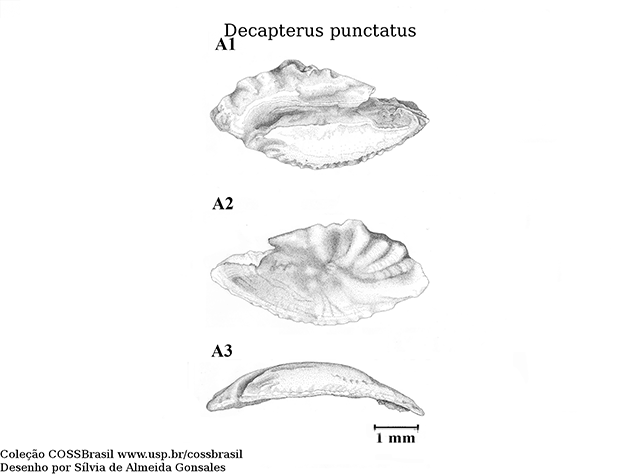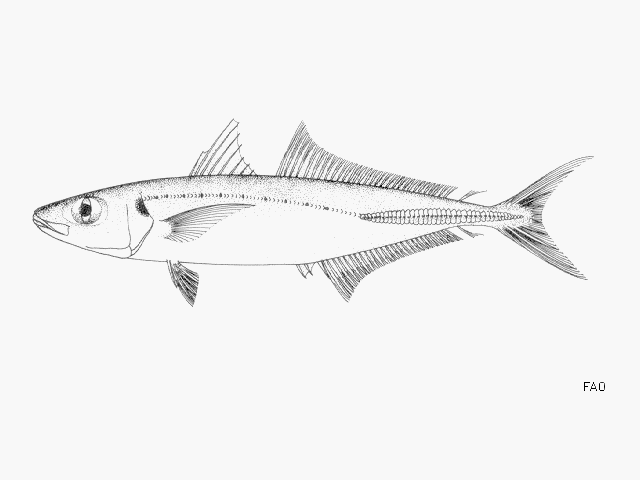Decapterus
punctatus
(Cuvier,
1829)
Round scad
View all media / Upload your photos and videos
Expand all
Classification / Names
Teleostei (teleosts) > Carangiformes (Jacks) >
Carangidae (Jacks and pompanos)
> Caranginae
Etymology: Decapterus: Greek, deka = ten + Greek, pteron = wing, fin (Ref. 45335).
More on author:
Cuvier.
Environment / milieu / depth range / climate zone / distribution range
Marine; reef-associated; depth range 0 - 100 m (Ref. 2683); subtropical; 45°N - 35°S98°W - 20°E.
Distribution
Maps

Decapterus punctatus / Native range
AquaMaps Data sources:
GBIF
OBIS
This map was computer-generated and has not yet been reviewed.

Decapterus punctatus / Suitable habitat
AquaMaps Data sources:
GBIF
OBIS
This map was computer-generated and has not yet been reviewed.

Decapterus punctatus / Point map
AquaMaps Data sources:
GBIF
OBIS
This map was computer-generated and has not yet been reviewed.

Decapterus punctatus / Year 2050
AquaMaps Data sources:
GBIF
OBIS
This map was computer-generated and has not yet been reviewed.
Length at first maturity / Size / Weight / Age
Short description
Biology
Adults inhabit neritic waters, often near sandy beaches (Ref. 5217). A shoaling species, generally near the bottom (Ref. 27121). They feed on planktonic invertebrates, primarily copepods, but also on gastropod larvae, ostracods and pteropods (Ref. 3277). Spawning occurs well offshore year-round (Ref. 26938). Eggs are pelagic (Ref. 4233). A good food fish (Ref. 9626). Caught commercially and used mainly for bait.
Main reference
Smith-Vaniz, W.F., J.-C. Quéro and M. Desoutter 1990 Carangidae. p. 729-755. In J.C. Quero, J.C. Hureau, C. Karrer, A. Post and L. Saldanha (eds.) Check-list of the fishes of the eastern tropical Atlantic (CLOFETA). JNICT, Lisbon; SEI, Paris; and UNESCO, Paris. Vol. 2. (Ref. 7097)
IUCN Red List Status (Ref. 125652)
Least Concern (LC); date assessed: August 20 2012
CITES (Ref. 131153)
Not Evaluated
CMS (Ref. 116361)
Not Evaluated
Threat to humans
Harmless
Human uses
Fisheries: minor commercial; bait: usually.
FAO - Publication: search | FIRMS - Stock assessments | FishSource | Sea Around Us
More information
- Countries
- FAO areas
- Ecosystems
- Occurrences
- Introductions
- Stocks
- Ecology
- Diet
- Food items
- Food consumption
- Ration
- Common names
- Synonyms
- Metabolism
- Predators
- Ecotoxicology
- Reproduction
- Maturity
- Spawning
- Spawning aggregation
- Fecundity
- Eggs
- Egg development
- Age/Size
- Growth
- Length-weight
- Length-length
- Length-frequencies
- Morphometrics
- Morphology
- Larvae
- Larval dynamics
- Recruitment
- Abundance
- References
- Aquaculture
- Aquaculture profile
- Strains
- Genetics
- Allele frequencies
- Heritability
- Diseases
- Processing
- Mass conversion
- Vision
- Pictures
- Stamps, Coins Misc.
- Sounds
- Ciguatera
- Speed
- Swim. type
- Gill area
- Otoliths
- Brains
Estimates based on models
Preferred temperature (Ref. 123201): 13.5 - 27.8, mean 24.3 °C (based on 900 cells).
Phylogenetic diversity index (Ref. 82804): PD50 = 0.501 [Uniqueness, from 0.5 = low to 2.0 = high].
Bayesian length-weight: a=0.01148 (0.00752 - 0.01752), b=2.99 (2.86 - 3.12), in cm total length, based on LWR estimates for this species & Genus-body shape (Ref. 93245).
Trophic level (Ref. 69278): 4.4 ±0.0 se; Based on diet studies.
Generation time: 3.5 ( na - na) years. Estimated as median ln(3)/K based on 1 growth studies.
Resilience (Ref. 120179): High, minimum population doubling time less than 15 months (K=0.32; tm<1; Fec=28,600).
Prior r = 1.20, 95% CL = 0.79 - 1.80, Based on 1 data-limited stock assessment.
Fishing vulnerability (Ref. 59153): Low to moderate vulnerability (34 of 100).
Price category (Ref. 80766): Medium; Questionable: based on ex-vessel price for species in this genus.
Nutrients (Ref. 124155): Calcium = 143 [39, 362] mg/100g; Iron = 1.97 [0.70, 4.60] mg/100g; Protein = 21.6 [20.2, 22.8] %; Omega3 = 0.358 [0.176, 0.741] g/100g; Selenium = 23.8 [7.1, 68.8] μg/100g; VitaminA = 36.4 [8.6, 154.8] μg/100g; Zinc = 0.817 [0.464, 1.440] mg/100g (wet weight); based on nutrient studies.

